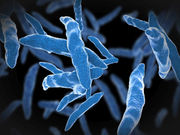Predicted resistance to rifampicin and isoniazid ID’d based on 238 mutations across 18 genetic loci
MONDAY, March 7, 2016 (HealthDay News) — In order to determine Mycobacterium tuberculosis drug resistance, a large number of mutations are needed, according to a study published online Feb. 24 in the American Journal of Respiratory and Critical Care Medicine.
Maha R. Farhat, M.D., from Massachusetts General Hospital in Boston, and colleagues aimed to create a comprehensive catalog of resistance mutations and examine their sensitivity and specificity in diagnosing drug resistance in M. tuberculosis. Inversion probes for DNA capture and deep sequencing of 238 drug resistance loci were developed for M. tuberculosis. The probes were used for targeted sequencing of a set of 1,397 M. tuberculosis isolates with known drug resistance phenotypes. A minimal set of mutations was identified that could predict resistance to first- and second-line anti-tuberculosis drugs; the predictions were validated in an independent dataset.
The researchers found that for rifampicin and isoniazid, the predicted resistance exceeded 90 percent sensitivity and specificity, while for other drugs it was lower. In order to diagnose resistance, a large number of mutations was needed; for the 13 drugs studied, 238 mutations across 18 genetic loci were needed.
“These data suggest that a comprehensive M. tuberculosis drug resistance diagnostic will need to allow for a high dimension of mutation detection,” the authors write. “They also support the hypothesis that currently unknown genetic determinants, potentially discoverable by whole genome sequencing, encode resistance to second-line tuberculosis drugs.”
Full Text (subscription or payment may be required)
Copyright © 2016 HealthDay. All rights reserved.








